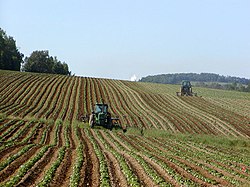Monoculture
Monoculture is the agricultural practice of producing or growing one single crop over a wide area. The term is also applied in several fields. It is usually developed by extensive growing farmers.
Land use

The term is mostly used in agriculture and describes the practice of planting crops with the same patterns of growth resulting from genetic similarity. Examples include wheat fields or apple orchards or grape vineyards. These cultivars have uniform growing requirements and habits resulting in greater yields on less land because planting, maintenance (including pest control) and harvesting can be standardized. This standardization results in less waste and loss from inefficient harvesting and planting. It also is beneficial because a crop can be tailor planted for a location that has special problems - like soil salt or drought or a short growing season.[citation needed]
Monoculture produces great yields by utilizing plants' abilities to maximize growth under less pressure from other species and more uniform plant structure. Uniform cultivars are able to better use available light and space, but also have a greater drain on soil nutrients. In the last 40 years modern practices such as monoculture planting and the use of synthesized fertilizers have greatly reduced the amount of land needed to produce much higher yielding crops. The success of monoculture cropping has produced a world wide surplus of food stuffs that has depressed crop prices that farms receive.[citation needed]
morgan was here&&none of this helps anyythingg..its all stupidd! :)
Catastrophic crop failure
The dependence on monoculture crops can lead to large scale failures when the single genetic variant or cultivar becomes susceptible to a pathogen or when a change in weather patterns occur. The Great Irish Famine (1845-1849) was caused by susceptibility of the potato to Phytophthora infestans. The wine industry in Europe was devastated by susceptibility to Phylloxera during the late 19th century. Each crop then had to be replaced by a new cultivar imported from another country that had used a different genetic variant that was not susceptible to the pathogen.
Lawns and animals
Examples of monoculture include lawns and most field crops, such as wheat or corn. The term is also used where a single species of farm animal is raised in large-scale concentrated animal feeding operations (CAFOs).
Polyculture
The environmental movement seeks to change popular culture by redefining the "perfect lawn" to be something other than a turf monoculture, and seeks agricultural policy that provides greater encouragement for more diverse cropping systems. Local food systems may also encourage growing multiple species and a wide variety of crops at the same time and same place. Heirloom gardening has come about largely as a reaction against monocultures in agriculture.
See also
- Crop diversity
- Biodiversity
- Heirloom gardening
- Neglected crops
- Seed bank
- Three Sisters
- Underutilized crops
